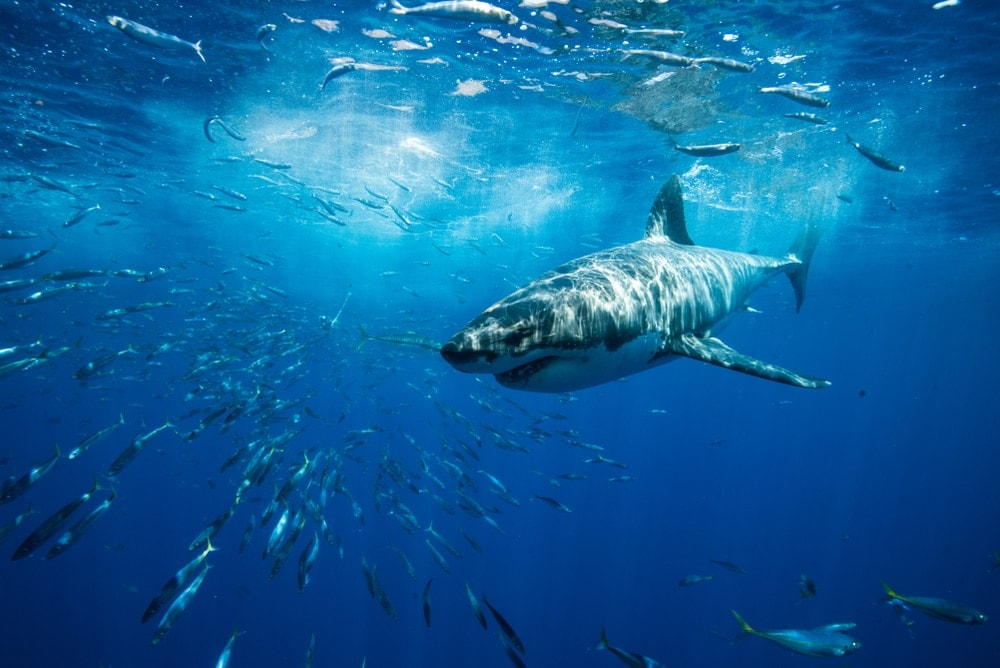
Sharks touch some part of our brains that we’ve forgotten about as we became more and more civilized. For some, just the thought of being in the water with a shark is petrifying, but this is the reality for millions of unknowing people each year.
Tourists and locals alike flock to the beaches of Florida in droves, likely not giving thought to what they share the water with. I can tell you from personal experience, there is no dividing line between you and sharks at the beach. The good news though, is that this isn’t a bad thing.
Florida is home to more than forty species of shark, but most of them aren’t considered real threats to people. In fact, shark bites are incredibly rare. Sharks themselves are fascinating, awe-inspiring creatures.
If you plan on going to Florida, it’s definitely worth knowing what sharks are in the water.
You May Also Like: Check Out These 3 Types Of Scorpions In Florida complete with Facts, Tips, Infographics, and more!
Florida Shark Species Identification Chart
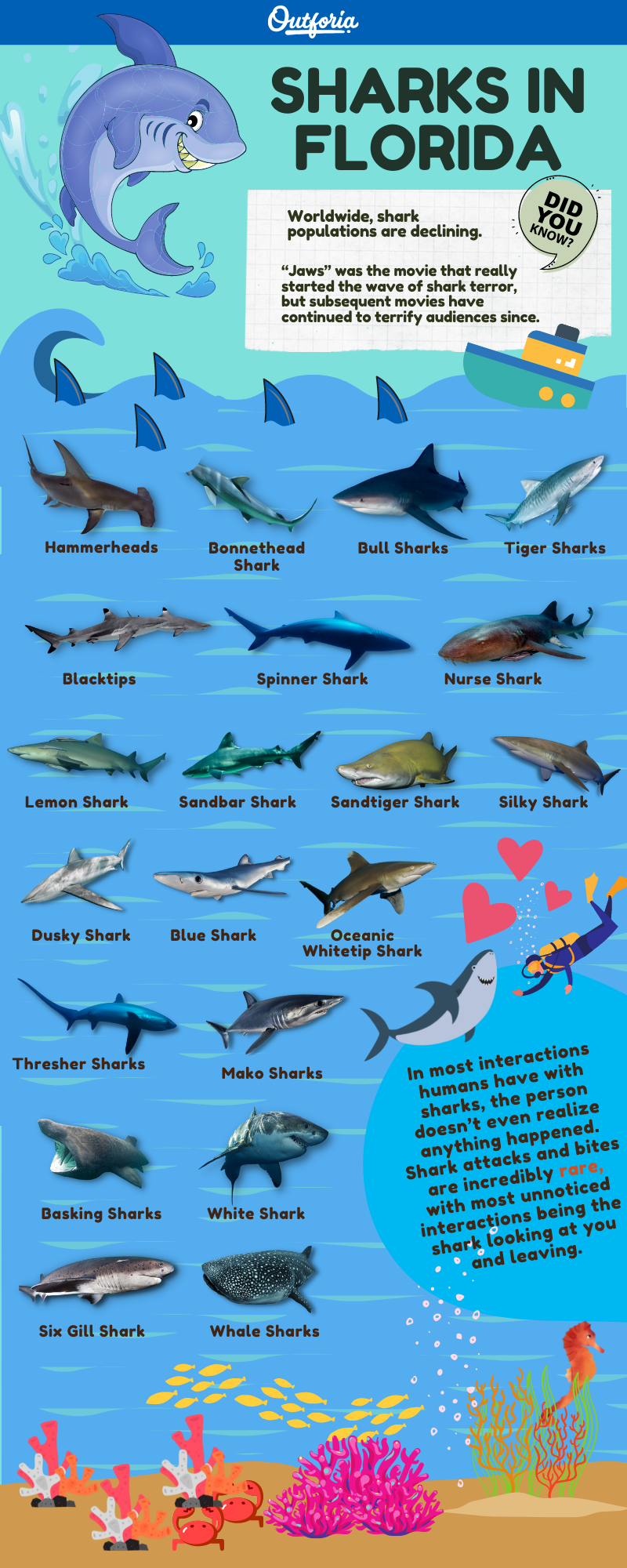
Share This Image On Your Site
<a href="https://outforia.com/sharks-in-florida/"><img style="width:100%;" src="https://outforia.com/wp-content/uploads/2022/01/Sharks-in-Florida-infographics-01112022.png"></a><br>Sharks in Florida Infographic by <a href="https://outforia.com">Outforia</a>16 Most Common Species of Sharks in Florida
1. Hammerheads (Sphyrnidae)
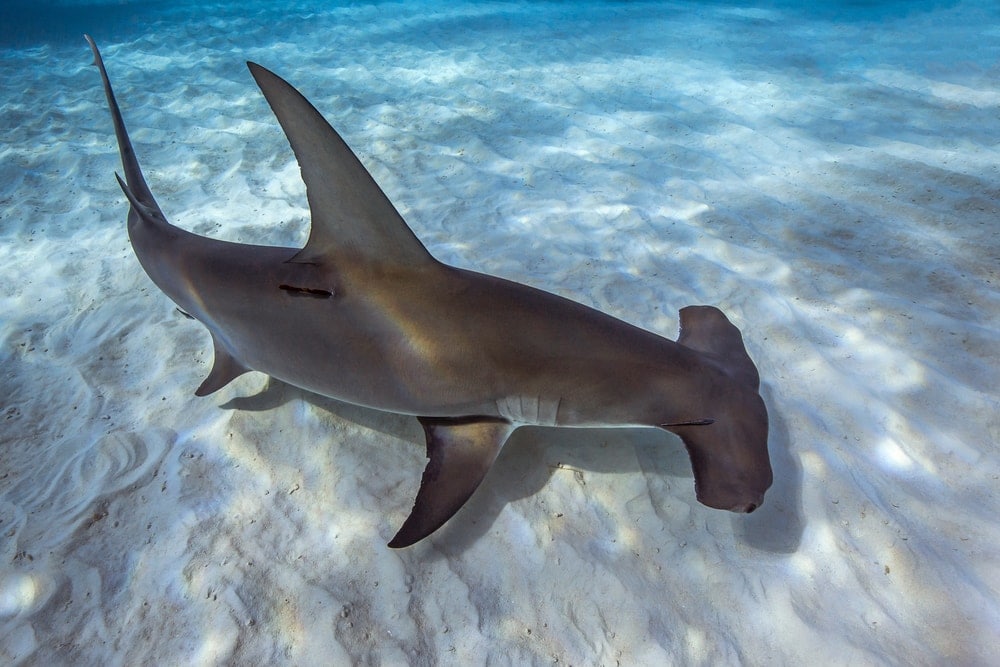
Hammerhead sharks come in a few different species, namely great hammerheads, scalloped hammerheads, and smooth hammerheads. They’re some of the most easily identified sharks thanks to their flat, hammer-shaped heads.
Most species grow to around nine feet (2.7 meters), but great hammerheads have been found to grow to 20 feet (6 meters) and average around 14 feet (4.3 meters) in length. You can find all of these hammerheads throughout Florida in coastal waters and around reefs and other structures offshore.
Like most other sharks, hammerheads primarily feed on anything that proves to be an easy meal. Favorite prey includes stingrays, skates, and large types of crabs they sense hiding in the sandy bottom of the ocean.
While other species of hammerhead group together in schools sometimes numbering in the hundreds, great hammerheads are solitary animals that typically only meet up around large food sources or to mate.
All hammerhead species are considered to be critically endangered.
2. Bonnethead Shark (Sphyrna tiburo)
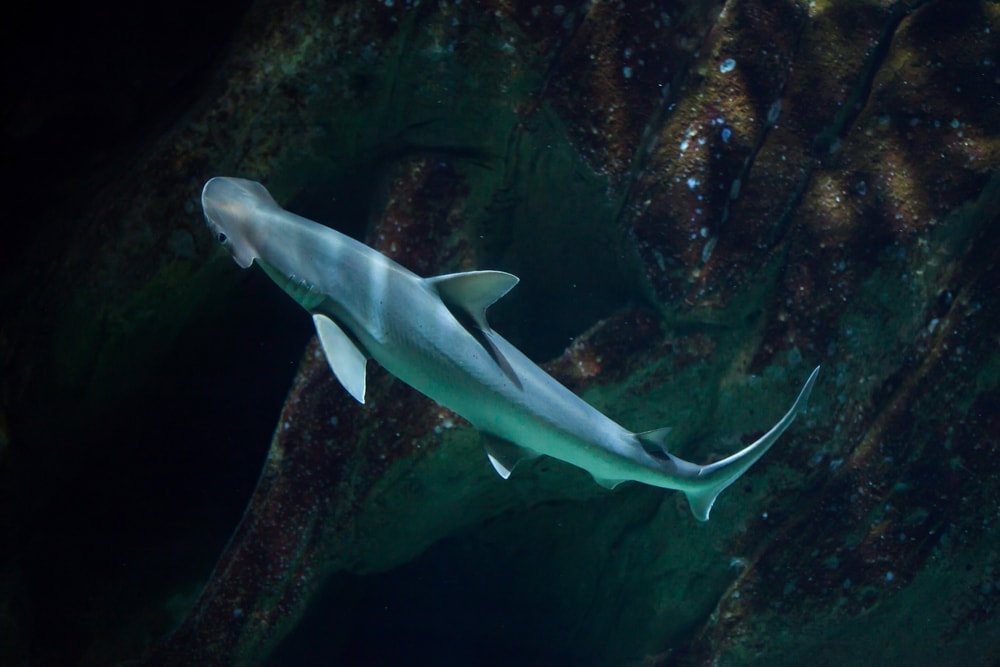
Bonnethead sharks are the little cousins of hammerheads and have a similar head shape. Unlike their larger cousins, bonnetheads average between three and four feet (0.9 – 1.2 meters) in length and are a popular species for very large saltwater aquariums.
Bonnetheads prefer shallow water and frequently are found in estuaries, surf zones, and shallow grass flats. They tend to migrate to warmer water during the winter.
These sharks eat mostly crabs, shrimp, and other invertebrates from the seafloor. Like hammerheads, they tend to swim in zig-zag patterns across the seafloor scanning for prey with their head.
Populations of bonnetheads in the Gulf of Mexico make them one of the most common sharks you’ll encounter. Despite this, the species is still endangered worldwide.
Bonnetheads are the only known shark species to exhibit sexual dimorphism in their head. Essentially, males and females have different head shapes, with males having a distinct bulge while females’ heads are more rounded.
They ingest a lot of seagrasses and it’s thought that they do this to protect their stomachs from the sharp edges of shellfish shells. They’re the only shark known to be omnivorous in this way.
3. Bull Sharks (Carcharhinus leucas)
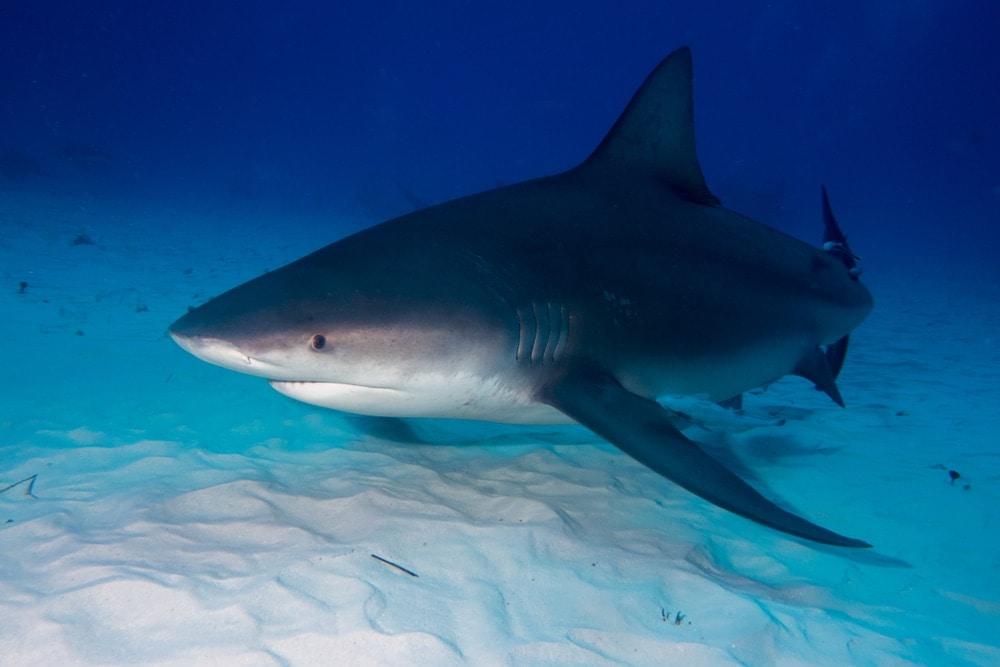
Bull sharks are one of the most commonly found sharks worldwide thanks to their unique adaptations for tolerating freshwater and general hardiness. They’ve even been documented to have traveled 1,100 miles (1,770 kilometers) up the Mississippi River from the Gulf of Mexico to Illinois.
Bull sharks generally grow to between eight and nine feet (2.7 meters) in length and can weigh upwards of 800 pounds (363 kilograms). They prefer warm, coastal waters and frequently cruise beaches, estuaries, bays, and river mouths.
Their ability to tolerate freshwater is rather unique to sharks. While a few species such as the Glyphis are freshwater species, bull sharks are saltwater sharks that simply have the means to deal with a wide range of salinities. In some places, bull sharks use rivers as breeding grounds.
Large bull sharks are responsible for the vast majority of nearshore shark bites inflicted on humans. They tend to be one of the most aggressive species of shark, due to their extremely high testosterone levels, fierce territorial behavior, and a zero-tolerance policy towards any kind of provocation.
Bull sharks are listed as a vulnerable species.
4. Tiger Sharks (Galeocerdo cuvier)
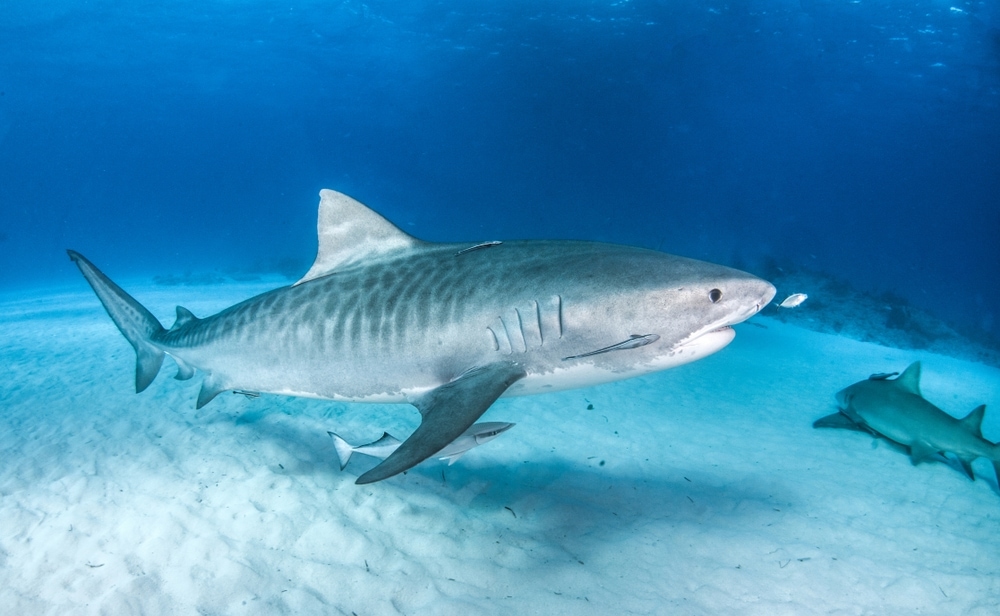
Tiger sharks are identified by the tiger stripes you can visibly see on their sides. They can grow over 16 ½ feet (5 meters) in length and prefer tropical and subtropical climates. In Florida, most of them are found around the Florida Keys and South Florida, but they’re known to wander northward in search of food.
The favorite prey for many sharks is sea turtles, but this is a rare treat. They have the widest selection of prey of any shark species and are known for eating quite literally everything. Rays, fish, turtles, other sharks, sea birds, squid, dolphins, and crustaceans are all on the menu. Sometimes they even eat manmade products like bits of tires, metal, or whatever other garbage has been floating around.
Tiger sharks are the second most deadly for humans, just behind the great white in the number of fatal attacks on people. These attacks happen extremely rarely, though it’s always safer to exit the water than share it with a 15-foot (4.5 meters) indiscriminate feeding machine.
The species is listed as near-threatened.
5. Blacktips (Carcharhinus limbatus)
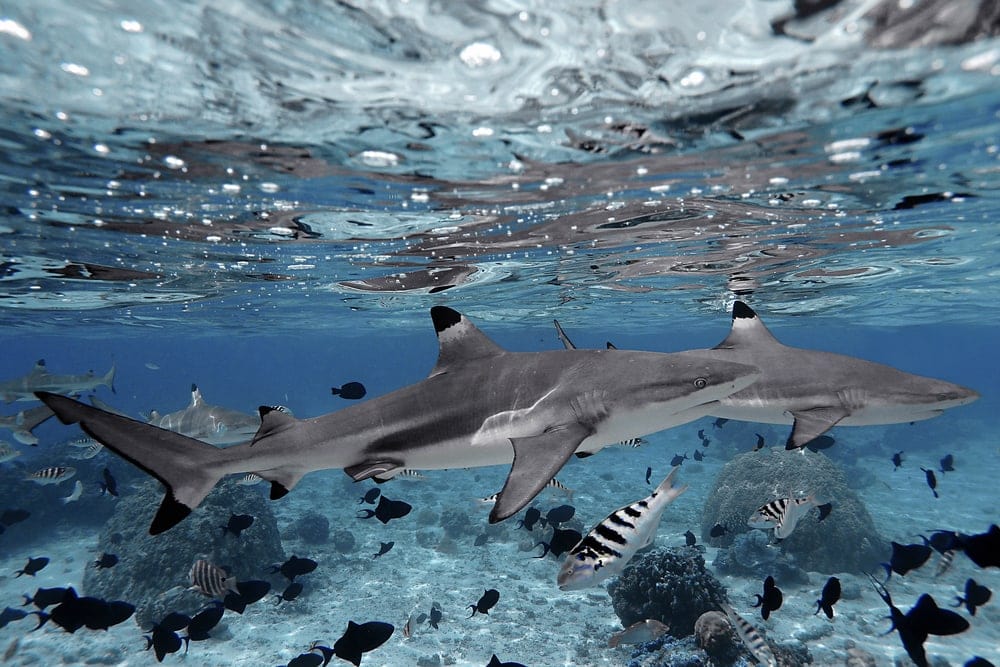
Blacktip sharks grow to around five feet (1.5 meters) in length and prefer brackish, coastal waters. You can identify them by their stout body shape and tell-tale black marking on the tips of their pectoral and dorsal fins.
Like the spinner shark, they’re known for leaping from the water when attacking schools of fish, which makes up most of its diet. They frequently follow traveling schools of fish down beaches and can gather in huge numbers during mating seasons like in the video here.
They can be aggressive during feeding, leading to reports of attacks on people. Due to a smaller mouth size though, they aren’t considered major threats even in the event of an attack.
Blacktips are listed as a vulnerable species. This is mostly due to their importance in commercial and recreational fishing, where their meat, fins, and organs are all valued.
6. Spinner Shark (Carcharhinus brevipinna)
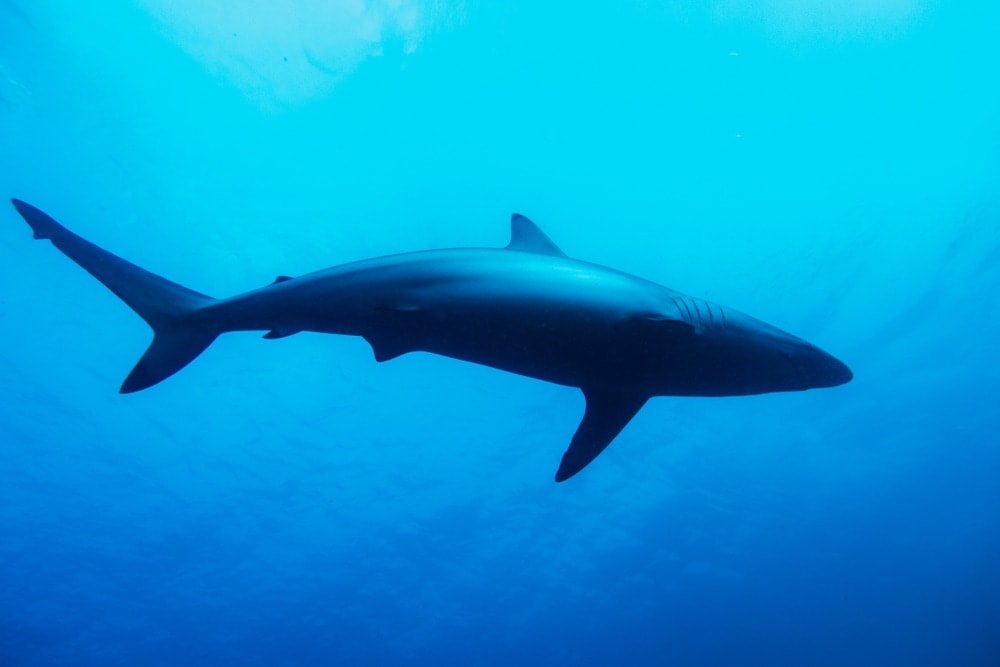
The spinner shark and blacktip are very similar. They both have black markings on their fins and will (more so for spinners) frequently leap from the water when attacking prey. You can distinguish a spinner from a blacktip by the black-marked anal fin and a further back dorsal fin.
They also grow larger, reaching nearly ten feet (3 meters). Spinner sharks prefer shallow water, and a favorite strategy when feeding on schools of fish is to attack from below, spinning while breaching out of the water. In many cases, their entire body leaves the water and contorts like a skateboarder performing a trick.
The shark has very good table-quality meat and is known as a fantastic fighter as it will perform its leaping behaviors when hooked.
The species is listed as vulnerable.
7. Nurse Shark (Ginglymostoma cirratum)
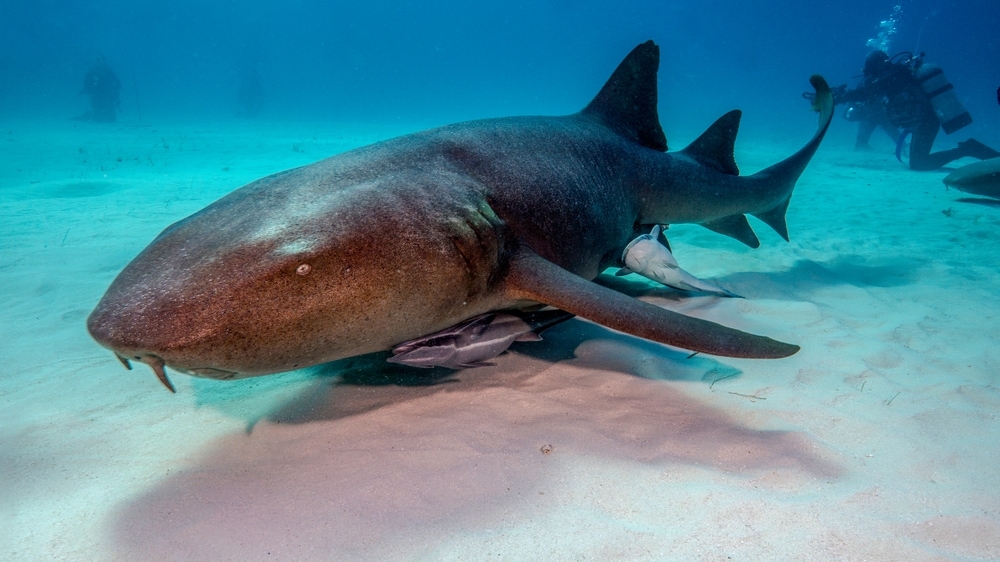
Nurse sharks are known as almost acting like puppies sometimes thanks to their docile nature. They’re one of the few species of sharks that lie on the seabed in place. They have two barbels over their mouth, large rounded fins, and are generally brownish overall.
While they’re tolerant of being touched, tagged, or handled (compared to other shark species), they’re ranked as the fourth highest in numbers of bites on humans. This is mostly due to the fact that they frequent shark-feeding dive areas and their docile nature leads divers to not be careful with them.
Nurse sharks typically grow to be around ten feet (3 meters) in length. They’re a common aquarium species because of how little room to move they need in comparison to other sharks, as well as their generally agreeable nature.
Nurse sharks are opportunistic feeds that wait on small fish and rays to wander too close. They are capable of generating some of the highest suction forces of any invertebrate species. It’s common for them to be found lying on the bottom in large groups.
The species is listed as vulnerable.
8. Lemon Shark (Negaprion brevirostris)
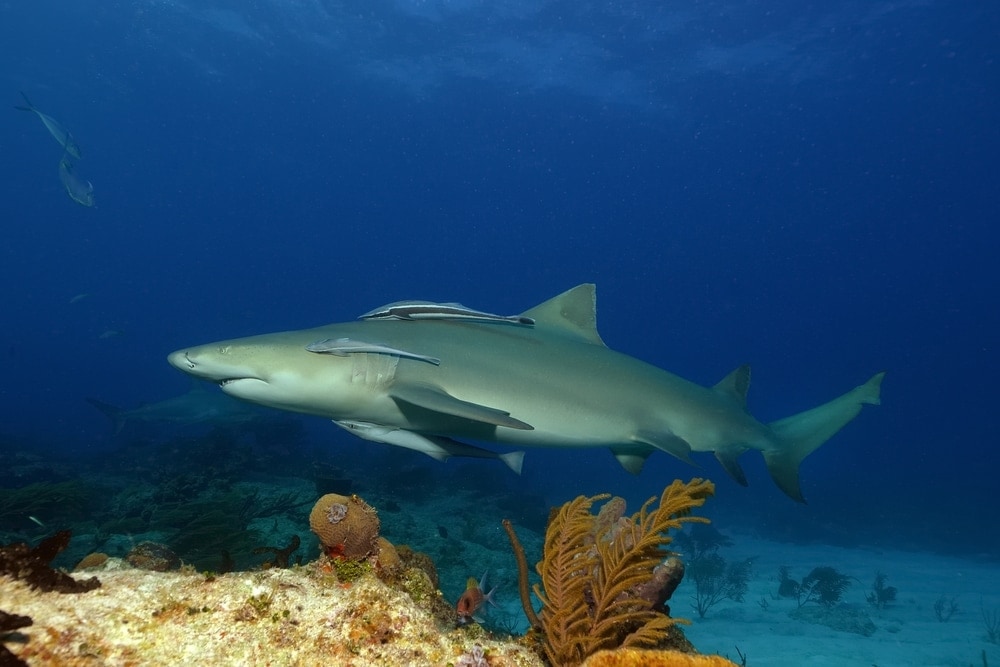
Lemon sharks spend time in groups and search out fish in the warm, shallow waters they call home. They have a sandy-yellow coloration that helps them blend in while cruising above the bottom and grow to around eleven feet (3.3 meters) in length.
Very few shark attacks have been attributed to lemon sharks, as they tend to be slightly skittish towards humans. They typically form groups with sharks of similar size.
Lemon sharks always return to the nursery of their birth to give birth themselves. You’ll find them along coastlines, bays, and grass flats more than you will offshore.
The species is listed as vulnerable.
9. Sandbar Shark (Carcharhinus plumbeus)
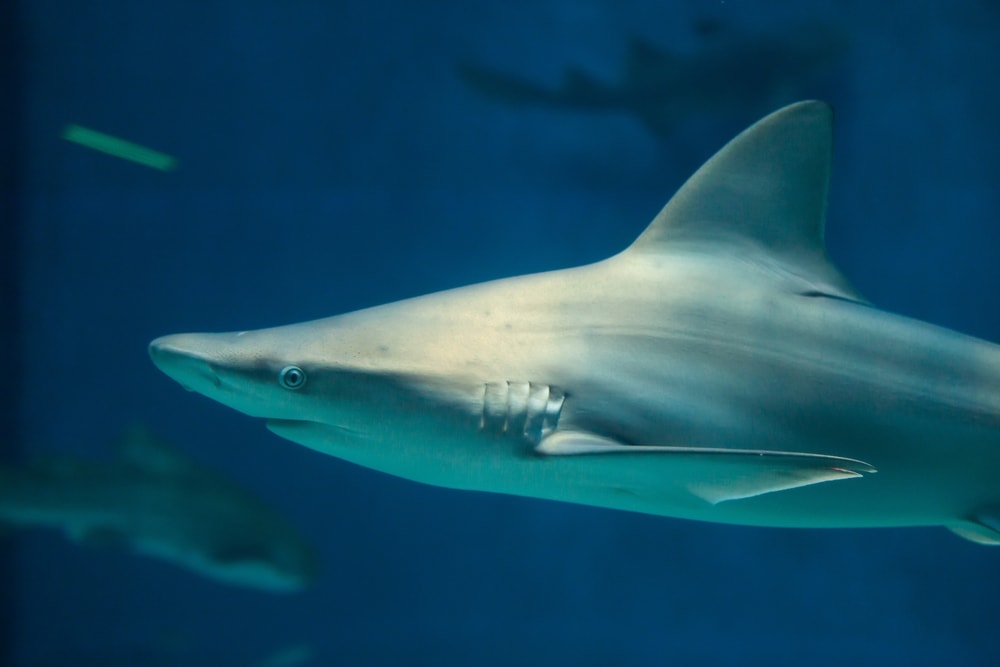
Sandbar sharks are closely related to bull sharks and have a very tall dorsal fin and brown coloration. They’re one of the largest coastal sharks in the world, growing to around eight feet (2.4 meters) in length and very stocky.
For the most part, they feed on fish, rays, and crustaceans. They spend a lot of time in intertidal zones, bays, and estuaries, preferring the shallow nearshore waters to deeper offshore areas.
Thanks to their large dorsal fins, sandbar sharks have been targeted more by commercial fisheries looking for shark fins for shark fin soup. This has led to a decline in population and a moratorium on landing the species in the United States.
The species is listed as endangered.
10. Sandtiger Shark (Odontaspis taurus)
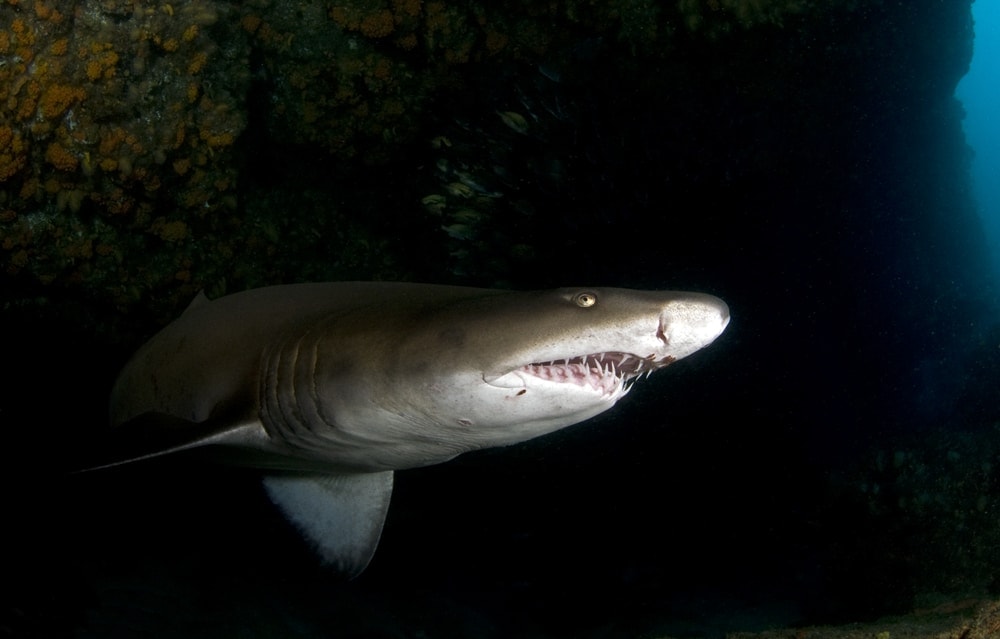
Sandtiger sharks have a fearsome set of teeth but are slow-moving and generally placid. You can identify them by their pointy head, grey coloration, and chunky body with an arched back. They typically reach around ten feet (3 meters) in length.
Sandtigers are rather special in a couple of different ways. Namely, they can come to the surface and gulp down air to help them with their buoyancy. They also practice cannibalism while in the womb, like some other species of shark. The most developed embryo during pregnancy feeds on the other embryos.
Thanks to their ability to adapt to captivity well, they’re one of the most widespread species of sharks found in aquariums.
The species is listed as critically endangered.
11. Silky Shark (Carcharhinus falciformis)
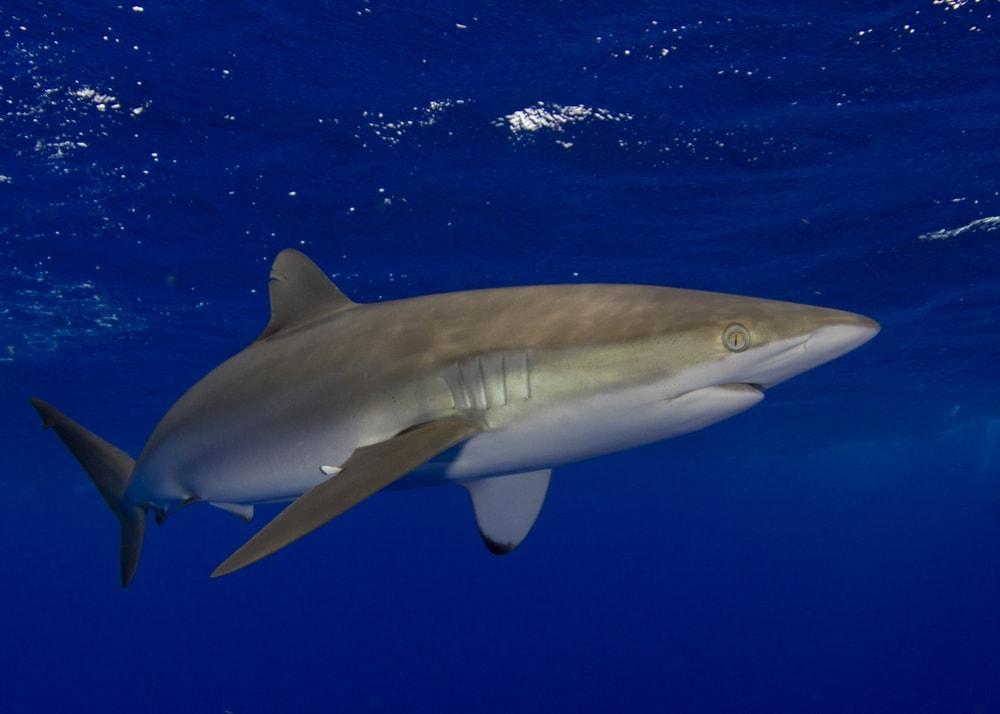
Silky sharks have smooth grey skin, grow to over eight feet (2.4 meters) in length, and spend most of their time in deep offshore waters. You can most commonly find them along the edges of continental shelves, but they also come closer to shore in search of food.
They migrate huge distances, following in the footsteps of fish and squid schools.
They can be identified further by their distinct sickle-shaped tail and large eyes. Silkies can act aggressively towards people, but due to their pelagic lifestyle, they rarely come into contact with humans.
The species is listed as vulnerable.
12. Dusky Shark (Carcharhinus obscurus)
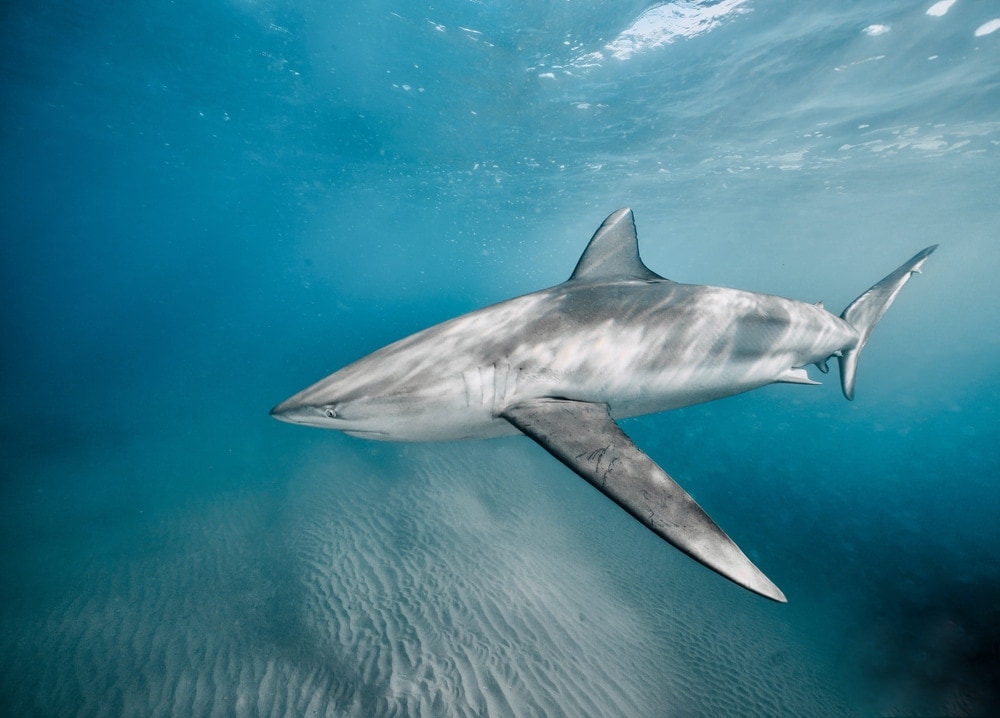
Growing up to fourteen feet (4.3 meters) in length, you can identify dusky sharks by their typical dark-colored backs, slender body, and huge pectoral fins. They’re found everywhere from the coastline to the pelagic zone of the continental shelf.
Dusky sharks migrate vast distances each year, heading towards the poles in the summer and the equator during winter. Duskies eat pretty much everything, from fish and rays to crustaceans and even garbage.
They have a slow reproductive rate, leading to them being listed as a vulnerable species despite strong population numbers.
13. Blue Shark (Prionace glauca)
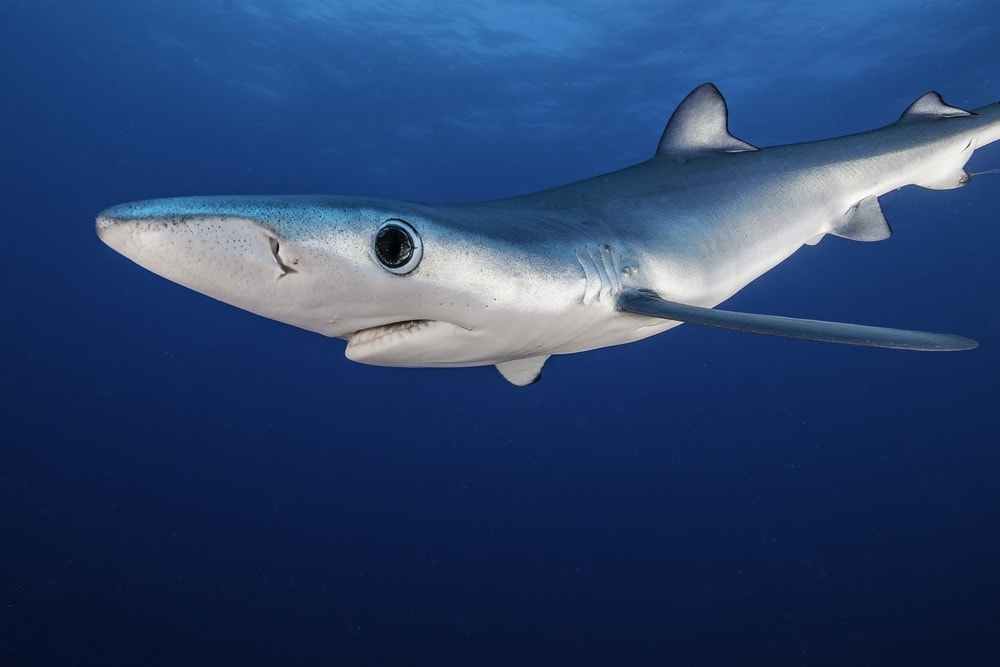
Blue sharks get their name from the deep blue color covering the top of their body that helps them blend in with the deep blue water they inhabit. They grow to an average of ten feet (3 meters), but have the potential to grow further, and have slender bodies.
Blue sharks can be found everywhere in the world except Antarctica, and spend most of their time in pelagic zones with water depths of over 400 feet (122 meters). Most of their diet consists of squid, but they also eat cuttlefish, bony fish, and crustaceans.
They’re known as opportunistic feeders that have even eaten whale blubber from carcasses. Blue sharks are known to school up and hunt in packs, driving schools of fish into balls that they can then eat at their leisure.
Despite being frequent by-catch for long-line fishermen, blue sharks have extremely high reproductive rates. A single pregnancy can produce between 4-135 shark pups, which is a large reason why their population numbers remain high.
The species is listed as not threatened.
14. Mako Sharks (Isurus oxyrinchus)
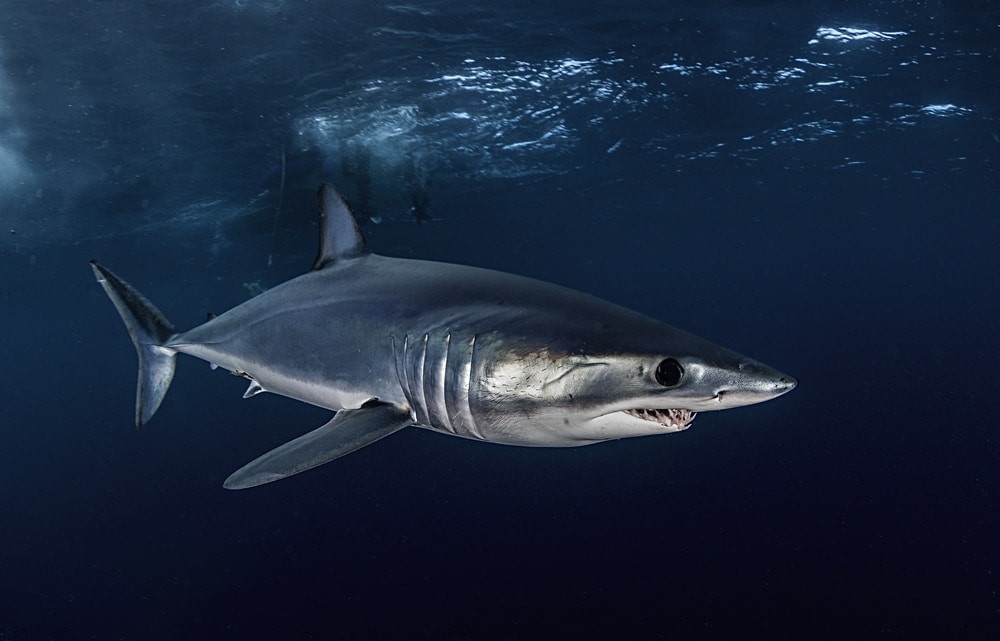
You can find both shortfin and longfin mako sharks off the coast of Florida. Makos are shaped like torpedoes, with large teeth and massive eyes. They’re also exceptionally heavy for their sizes, with makos averaging ten feet (3 meters) in length at 300 pounds (136 kilograms), with fourteen-foot (4.2 meters), 1,200-pound (544 kilograms) specimens being caught.
Both species prefer offshore habitats and deeper waters, primarily feeding on bony fish like tuna and cephalopods like squid.
Makos are prized by fishermen for their incredible ability to fight while hooked on a line. They frequently jump from the water and reach insane speeds. Shortfin makos are one of the fastest swimming creatures on the planet, able to cruise at over 30 miles (48 kilometers) per hour and can burst up to 46 miles (74 kilometers) per hour.
Makos are known to be dangerous to humans, but most attacks are the result of a provoked fish being brought onto the deck of a boat that had hooked it while fishing.
Both varieties of mako sharks are listed as endangered.
15. Oceanic Whitetip Shark (Carcharhinus longimanus)
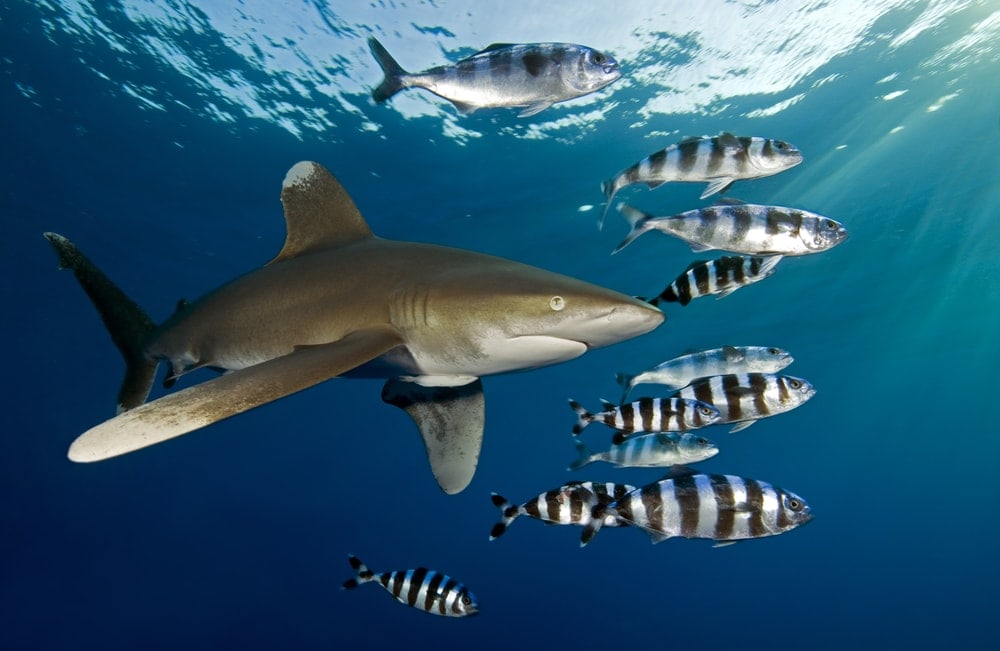
Oceanic White Tips spend all of their time far out at sea and are known as a pelagic species. They average around ten feet (3 meters) in length but can grow to over thirteen feet (4 meters). You can identify them by their aggressive attitude, signature white marking on their dorsal fin, and stocky body with almost cartoonishly large fins.
White tips are opportunistic predators that swim slowly. They spend all of their time in the typically barren open ocean, so they conserve energy in their movement and eat any time they can.
They can sniff or sense out food sources from incredibly far away and are known for congregating in large numbers on bait balls.
White tips are called sea dogs for a reason. They tend to follow ships or show up where people are diving due to their curiosity. This, combined with them traveling great distances towards sensed-out food sources is one of the reasons why they’re a threat to ship and plane wreck survivors.
The species is listed as critically endangered.
16. Thresher Sharks (Alopias)
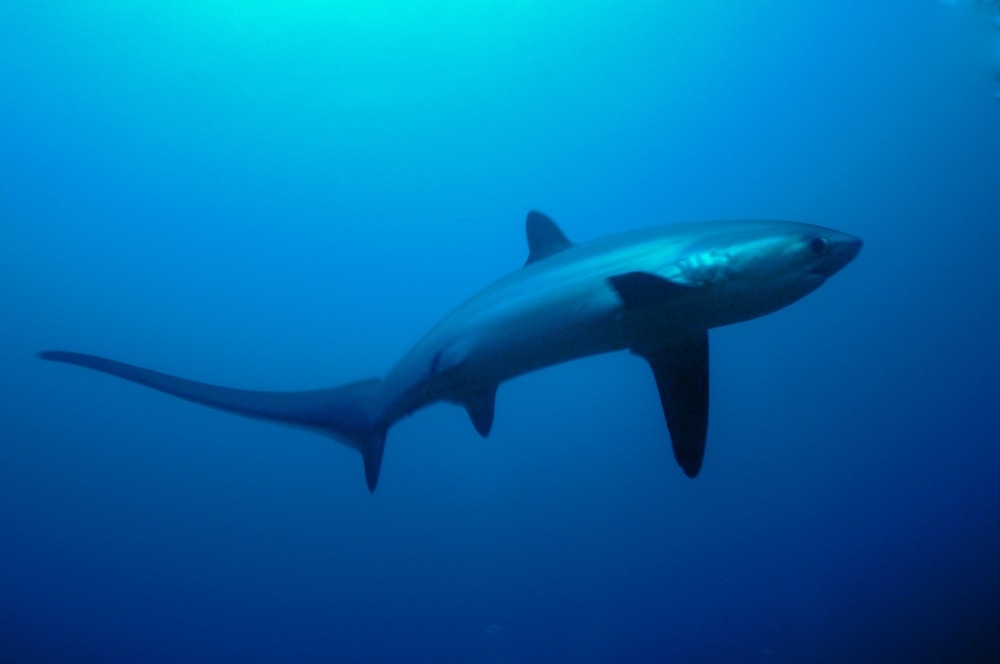
Thresher sharks stand out thanks to their elongated, whip-like tail that identifies them from other species. They spend the majority of their time in the open ocean feeding on Bonita, tuna, and other bony, open-water fish.
They’re known for using their tail as a weapon. When they move through a school of fish, they can whip their tail fast enough to cut fish in two or paralyze the prey they’re after. Among sharks, this behavior is unique.
The species is listed as vulnerable.
You May Also Like: Explore These 25 Different Types of Sharks with Photos, Cute Infographic, Facts, and more!
4 Other Florida Shark Species You’ll Find
As stated, Florida waters are home to well over forty species of sharks. Aside from the above which include the most common ones, a few famous species can be found here as well.
1. Whale Sharks (Rhincodon typus)

Whale sharks, the largest animal in the world outside of whales, can be found in the Gulf of Mexico. They’re filter feeders that eat plankton and other tiny organisms but can easily grow to fifty feet (15 meters) in length.
2. Basking Sharks (Cetorhinus maximus)
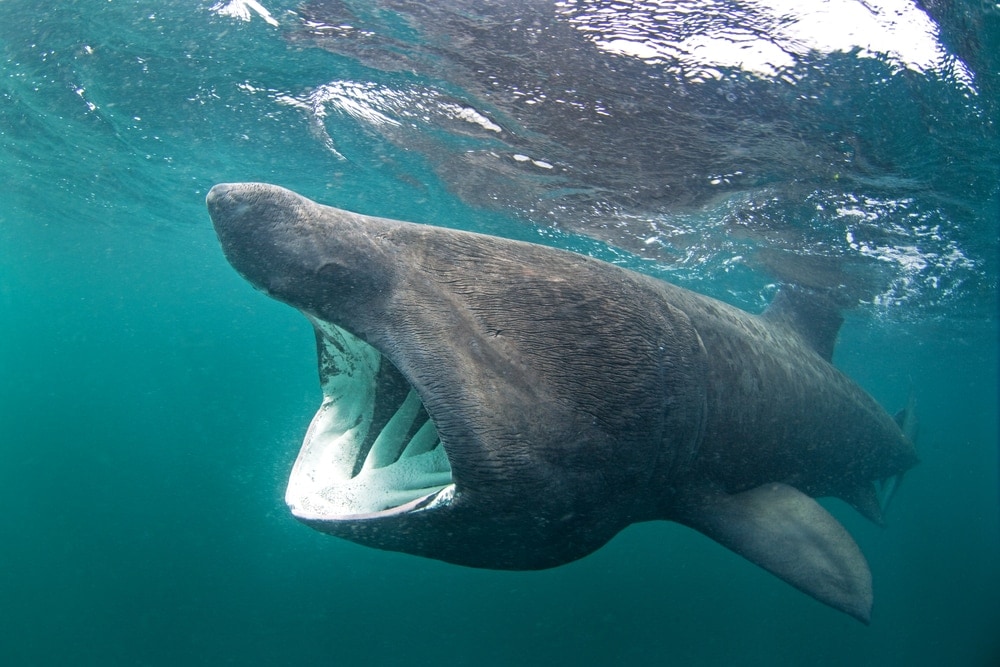
Basking sharks, another endangered filter feeder that can be mistaken for great whites, are also found off the Florida coast. Not much is known about the species aside from their feeding habits and massive size of over 30 feet (9 meters).
3. White Shark (Carcharodon carcharias)
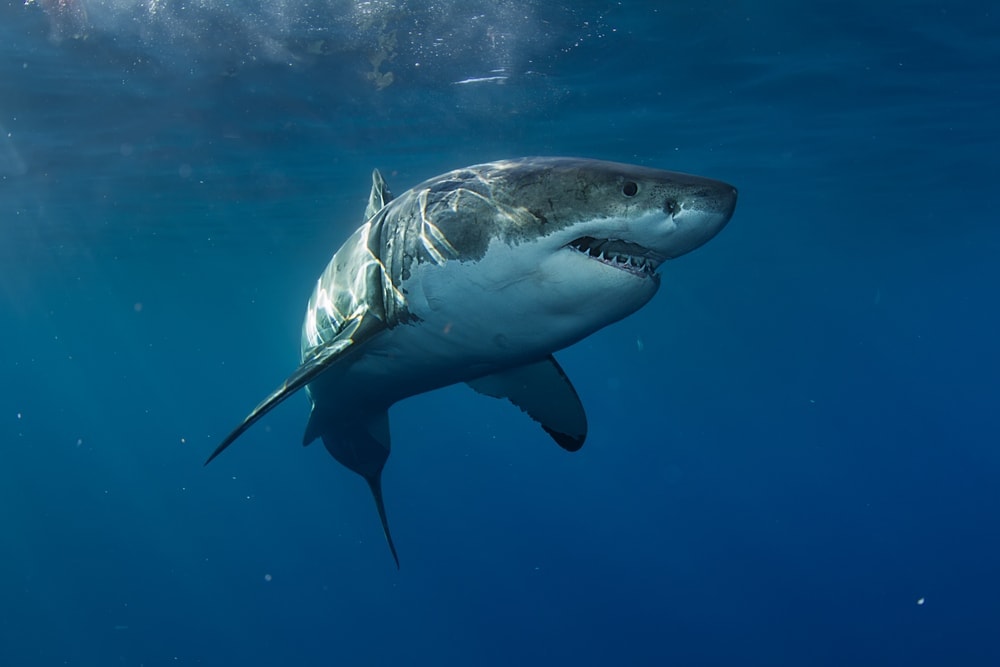
Speaking of great whites, they’re also known to migrate around Florida and into the Gulf of Mexico. Atlantic great whites commonly migrate between Maine and the Gulf of Mexico in search of food and breeding grounds. Great whites are known to grow over 20 feet (6 meters) in length and are recognized as the most deadly for humans. But we’ll touch on that in a later section.
4. Six Gill Shark (Hexanchus griseus)
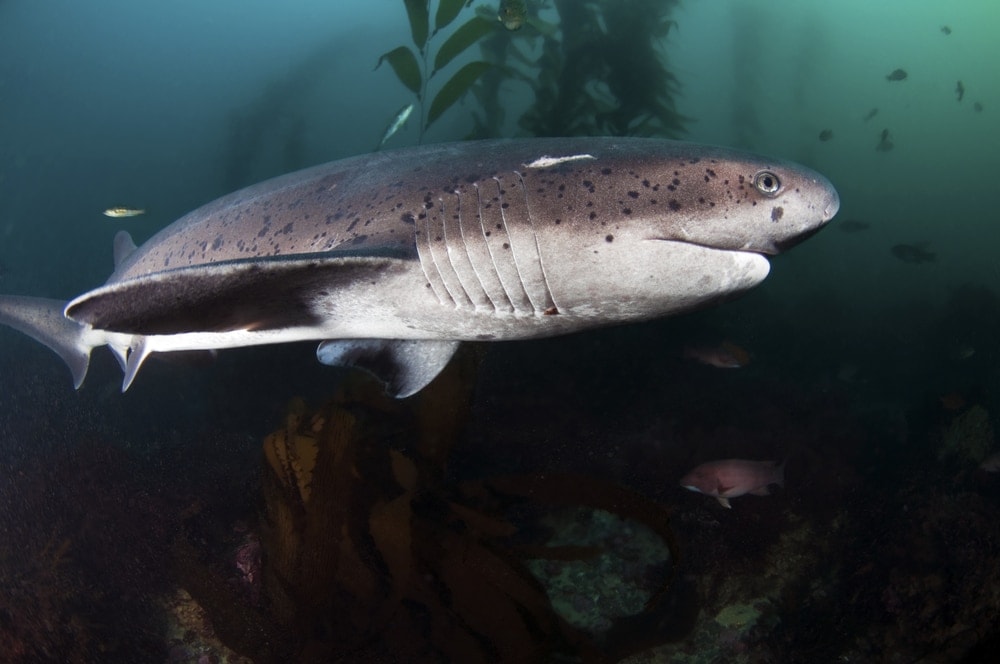
If you include the deep ocean off the continental shelf, you can count on finding dogfish sharks, cookie-cutter sharks, six and sevengill sharks, and even shark cousins like chimeras. You will certainly not encounter these species though, as they inhabit the deep ocean where light doesn’t reach.
You May Also Like: There Are 10 Common Sharks In Hawaii That You Should Know About with Photos, Infographics, Facts, and more!
Sharks of Florida And Human Interactions

In most interactions humans have with sharks, the person doesn’t even realize anything happened. Shark attacks and bites are incredibly rare, with most unnoticed interactions being the shark looking at you and leaving.
Each year in the wild, there are fewer than 80 shark bites each year. These bites are broken down into provoked and unprovoked bites. Provoked bites involve people initiating the interaction like unhooking them from a line, trying to handle them, or otherwise provoking the animal. Unprovoked bites are when the shark bites without known provocation.
In 2020, there were 39 provoked bites and 57 unprovoked bites. Of those, only 13 were fatal.
The United States leads the world in shark bites annually, with Florida being the state with the most incidents. You can find 2020 shark bite statistics here.
What’s important to remember is that most unprovoked bites are the result of territorial behavior or are what are called exploratory bites. Exploratory bites occur when a shark is testing to see whether you are food or not, likely because of a case of mistaken identity. In the vast majority of attacks, the shark bites once, and then it leaves.
From a shark’s point of view, a person in the water looks much like a seal or turtle (especially when on a surfboard). Typically, the shark bites, then realizes you aren’t food and lets go. In the case of large sharks like great whites and tiger sharks though, an exploratory bite leads to massive damage.
It’s important to stress that shark bites are extremely, extremely rare, and even when they happen are not typically fatal.
If you’ve ever swum in the ocean, you’ve likely been incredibly close to sharks. We aren’t typical food for sharks and sharks do not specifically target humans.
The water isn’t shark-infested, they live there, and you are the one trespassing. For information about how to share the water with sharks, check out this post by Florida Fish and Wildlife.
You May Also Like: Find Out These Different Animal Attacks In North America Including Its States With Most Deaths, Fatal Animal Attacks, and more!
Threats to Florida Shark Population
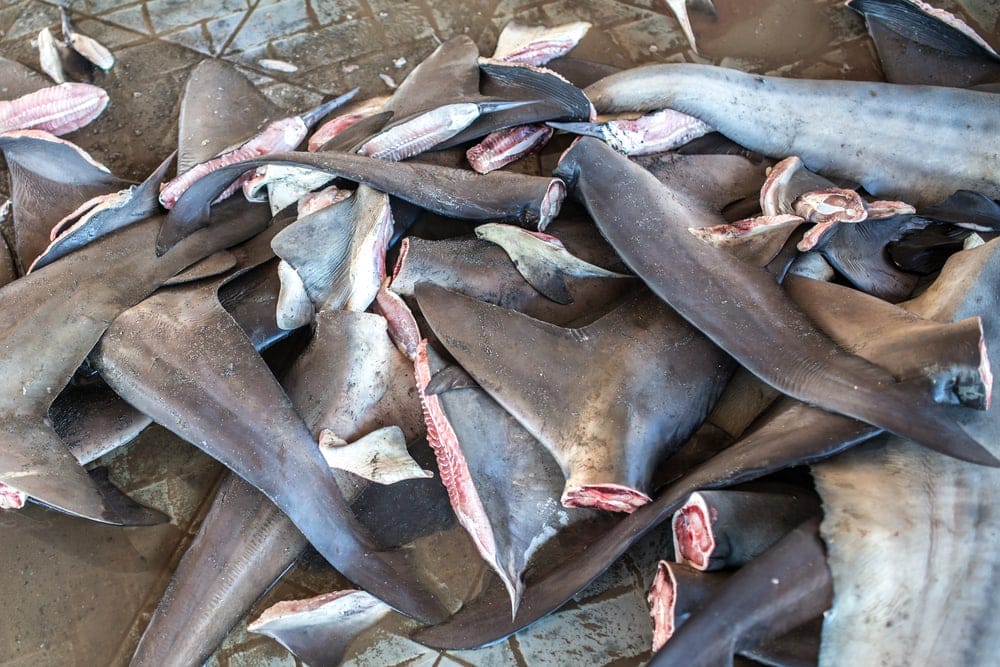
Worldwide, shark populations are declining. There are numerous factors that cause this, however, one of the biggest contributors is overfishing.
Each year, over 100 million sharks are caught specifically for their fins. Shark fin soup is a high-priced delicacy in Asia. Shark finning is banned by many countries due to ecological and ethical reasons.
In many cases, sharks are caught by fishing boats, brought aboard, and have their fins sliced off while still alive. The rest of the shark isn’t desirable, so the animal is thrown back into the water, without its fins, alive. The shark then dies, as it can no longer swim.
Some sharks are hit harder than others because of shark finning.
In addition to commercial shark finning, sharks are frequently caught as bycatch by trailers and long-line fishing vessels. In many cases, sharks die in the nets or on the lines, resulting in tens of millions of shark deaths each year.
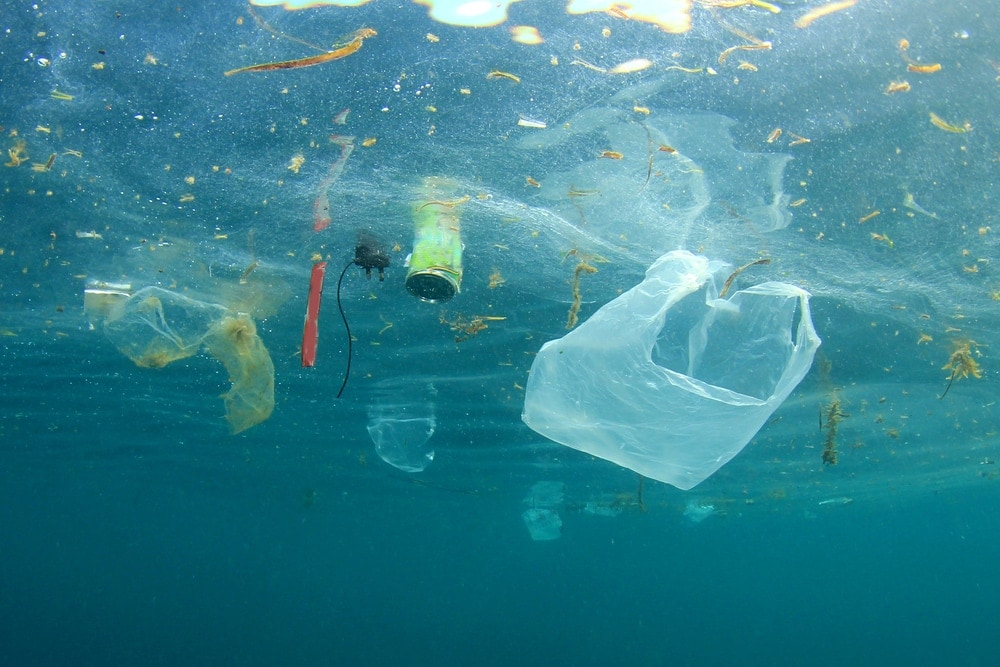
Ocean pollution and climate change are also endangering shark populations. Mercury and other chemicals in the water travel up the food chain to sharks, making them sick and infertile. As the climate warms, ocean acidification speeds up, harming the food chain from the bottom up.
Overfishing of shark prey species limits their food supply. As fish stocks dwindle due to a variety of factors, shark populations become unsustainable. As an example, the resurgence of seal populations in New England has resulted in a resurgence in great white populations thanks to available food. Unfortunately, the trend for all sharks is not going in that positive direction.
We are the biggest threat to sharks. Both through our indirect actions such as contributing to climate change and direct activities such as fishing and shark culls.
The reduction of shark populations has ripple effects throughout the entire food chain. They keep prey populations in check, and without enough apex predators, entire ecological systems will collapse.
You May Also Like: Learn What Is Poaching And Why Is It Practiced Including Its Effects with Infographics, Photos, Facts and more!
Historical Change in Sharks Living in Florida Waters
For many of the same reasons listed above as threats, shark populations in Florida are and have been on the decline. Not only are sharks finding it harder to grow in number, but they also have reproductive problems, habitat issues, and shorter life spans.
Shark Fishing
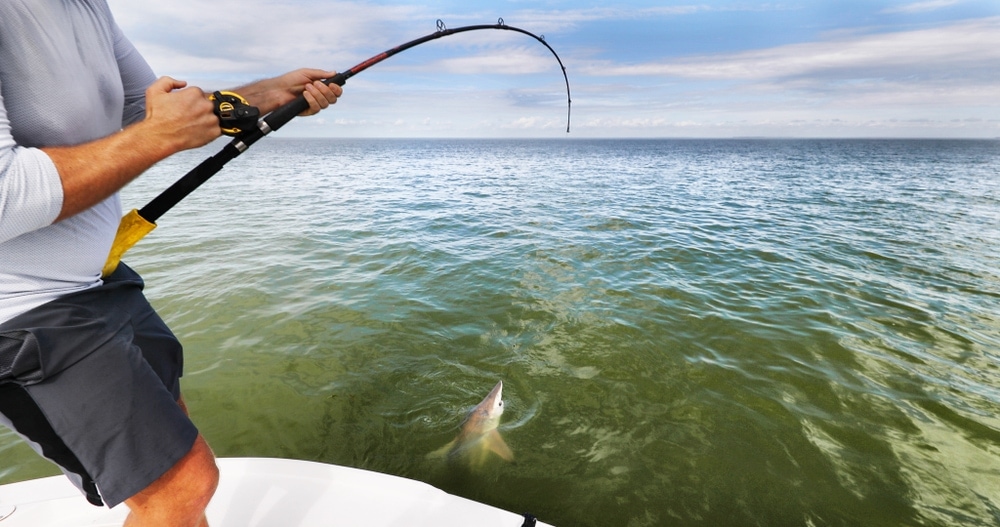
Sharks are caught for both commercial and recreational purposes.
For commercial reasons, sharks are caught for their meat, skiing, teeth, fins, and organs. Shark finning, as described above, is driven by the demand for shark fin soup. Their skin can be made into leather and many of their organs are used in medicinal practices such as Traditional Chinese Medicine.
Many sharks are prized as trophy fish by recreational fishermen because of their spectacular and powerful fighting skills. Sharks are targeted in a variety of ways by recreational fishermen, from shore, and by boat.
Fishing from boats, many fishermen target offshore species like mako sharks and threshers. From shore, spinners, blacktips, and bull sharks are the common targets. Typically, large gear is used to bring in big sharks quickly, however, smaller sharks are often caught by accident on baits like shrimp and squid.
The unfortunate truth about shark fishing for fun is that many sharks don’t survive. Sharks release cortisol when stressed (like fighting on a line). Different species respond differently to the buildup of stress hormones. Survival rates vary, with some species like bull sharks having high survival rates of 97%, while others like hammerheads die at a rate of between 40-70%.
It does not matter if the animal isn’t injured during the capture and release process, nor does it matter if the animal recovers and swims away seeming like it’s fine.
This information is a contributing factor to why I personally quit targeting sharks for catch and release. No matter how fast you bring the animal in, unhook it, and get it back in the water, the likelihood of the animal surviving is low.
As a Florida fisherman and former shark fisherman, I would discourage others from targeting sharks for fun. Even with the best of intentions, there is too much outside of your control to be considered a responsible angler.
Cultural References

Sharks dominate the cultures of coastal and island peoples throughout history.
They’ve even made their way into pop culture, and a shark bite is a major headline (mostly thanks to how rare they are).
“Jaws” was the movie that really started the wave of shark terror, but subsequent movies have continued to terrify audiences since. 47 meters down, The Shallows, Deep Blue Sea, The Meg, and Sharknado are all centered around sharks.
Humans have a primal response to sharks, the same way we have one towards tigers, lions, and bears. As something that can treat us as prey, we innately fear sharks. Today, we have very little to fear from the animals. As their biggest threat, we need to improve our stewardship of shark populations.
You May Also Like:
Discover different species found in Florida here:

Wild Monkeys In Florida | Poisonous Frogs In Florida | Anoles In Florida | Birds Of Florida | Vultures In Florida | Woodpeckers In Florida | Hawks In Florida | Florida Freshwater Fish | Florida Frogs | Scorpions In Florida | Geckos In Florida | Florida Spiders | Lizards In Florida | Owls In Florida | Florida Turtles | Snakes In Florida | Beach Birds Of Florida | Largest Alligator In Florida |









